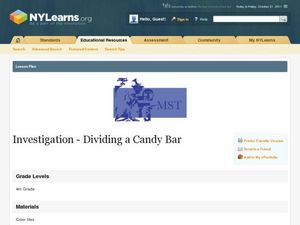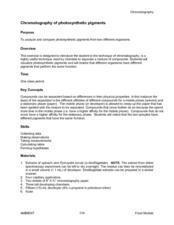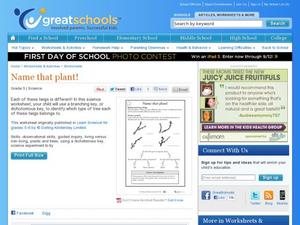Curated OER
Pizza Portions
Students explore mathematics by participating in a pizza pie activity. In this nutrition lesson, students identify the caloric intake in a piece of pizza and estimate the average number of slices eaten by a person. Students utilize...
Curated OER
Dividing a Candy Bar
Fourth graders explore number values by utilizing a candy bar in class. In this fraction lesson, 4th graders divide pizza and candy amongst each other in order to identify parts of a whole and fractions. Students answer several fraction...
Curated OER
Choose Your Vegetables
Students explain the importance of incorporating vegetables in their diet. In this adult health lesson, students identify common and uncommon vegetables in their area. They discuss ways to prepare and store them for future use.
Curated OER
Balanced Meal Planner
Students use an online website to select foods and put them onto a plate to see if they have made healthy and balanced meals. In this healthy meals lesson plan, students review the food pyramid before this activity.
Curated OER
Chromatography of photosynthetic pigments
Students explore the technique of chromatography to separate compounds in a mixture. In small groups, they separate by paper chromatography and identify the major and accessory photosynthetic pigments.....................................
Curated OER
Is it alive?
Kids in grades K-2 increase their logical reasoning and visual discrimination skills by determining which things shown are alive. They use the criteria that all living things move on their own to mark each image as alive or not.
University of Georgia
The Power of Peanuts
Measure the amount of energy in a peanut by igniting a chemical reaction. Classes use a laboratory setup to burn a peanut and measure the amount of heat it releases through a temperature analysis. They calculate the number of Joules of...
Curated OER
Fueling Body Activities - Digestion
Not only is the human digestive system covered in this biology worksheet, learners will also explore the digestive process of other animals. The 30 short-answer questions address modes of heterotrophic nutrition, the function of each...
Arcademics
Ratio Martian
Identify the correct ratios for food. Pupils play a six-level online game to practice identifying ratios. Learners see ratios in several forms mixed in with non-ratio quantities. Individuals click on each ratio to feed the hungry martian...
PBS
Reading Adventure Pack: Farms
A Reading Adventure Pack features a fiction and nonfiction text—The Oxcart Man by Donald Hall and illustrated by Barbara Cooney and Farming by Gail Gibbons. Following the readings, scholars make a collage showcasing foods farmed from...
Curated OER
Communication, Day 3: Asking What You Want
Mild to moderately disabled secondary students practice asking for what they want. They discuss a scenario, list things they want, then practice asking for those things. Our special needs students need to know how to communicate...
Curated OER
The Human Organism
Students identify their feelings and learn constructive ways of handling conflict. In this human mental health lesson plan, students identify their feelings, learn how to tell others about their feelings, and learn how to resolve...
Curated OER
Beginning Short Stories - "What Do We Have to Eat?"
After reading two short stories, learners identify vocabulary associated with food and eating. This activity with 5 questions could be used as a reading comprehension and vocabulary practice for younger students or an ESL worksheet for...
National Wildlife Federation
Plastic in the Sea
How much plastic do people use? Class members identify how plastic is involved in their daily lives by looking at food packaging either at a grocery store or at home. Learners view statistics for the amount of plastics found on a beach...
Baylor College
The Variety and Roles of Microbes
Mini microbiologists play a card game in which they group microorganisms by groups: virus, fungus, protist, or bacteria. Then they identify the roles different microbes play in the natural world and explore how humans effectively use...
Sharp School
You Can't Buy Love - But You May Need Toilet Paper
What will I be? What do I want to be? What will I have to do to achieve this goal? These are the essential questions that launches a research project that asks like-minded individuals to identify their goals, the costs of the practical...
Franklin D. Roosevelt Presidential Library & Museum
What Does It Mean to Be an American?
A series of four activities focuses young scholars' attention on what it means to be an American. They identify key qualities, values, and virtues they consider shared by Americans. Participants then pretend they have been selected to...
Curated OER
China: Land Beyond the Wall
An excellent series of five lessons on China awaits you and your young geographers. In these lessons, learners engage in hands-on activities, watch streamed video, access websites, and complete activities in cooperative groups in order...
Curated OER
Name that plant!
What is a dichotomous key? When your kids ask, hand them a learning exercise like this one, to explain it. They use the key to identify four different trees, based on the budding twigs they've produced. Tip: Have learners extend this...
Curated OER
Nutrition
Students determine which foods help keep our bodies healthy. They identify the six food groups and classify different food items into the correct categories of the food pyramid. They evaluate for one week the foods that they eat and...
Curated OER
Basic Needs of Living Things - Lesson Two
Fourth graders study and identify the basic needs of a variety of organisms. Terrariums and aquariums are used to demonstrate what plants, animals, and fish need to stay alive. These two classic models are used to effectively convey what...
Curated OER
Animals and Their Personalities
Now that your young Spanish speakers know the Spanish words for common animals, discuss what each animal eats and their personalities. It's great that the class starts by looking at an animal, identifying a characteristic or trait it...
Education Outside
What Are Grains?
This activity is like having a show-and-tell. Bring in lots of items, or packaging, from the grain group. Bread, rice, cracker, cereal, oats, you get the idea. Perhaps first start by checking in and asking what the class knows about...
Curated OER
Fill The Bill
Students identify and describe five different types of beaks. Using that information, they explain how each of them is adapted to feed on different foods. In groups, they travel around the room to various stations in order to practice...

























